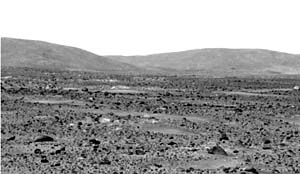Numerous people from the University are making critical contributions to the ongoing Mars mission.
Raymond E. Arvidson, Ph.D., the McDonnell Distinguished University Professor and chair of earth and planetary sciences in Arts & Sciences, is the mission’s deputy principal scientist.

Arvidson will remain at NASA’s Jet Propulsion Laboratory (JPL) in Pasadena, Calif., during the spring semester, as will most of the Washington University faculty working on the mission.
“We are all part of the Science Working Group, charged with planning observations and interpreting the data,” Arvidson said.
NASA’s twin rovers, Spirit and Opportunity, have been deployed successfully, with Opportunity detecting the presence of gray hematite, a find suggesting the possibility that the planet once had water on its surface. Hematite is an iron oxide mineral that may have formed in old lakebeds or possibly in iron-rich volcanic ash.
This week and next, Spirit will finish its measurements of rocks and soils in Gusev Crater and then move onto a long traverse into the ejecta from Bonneville Crater, located 250 meters to the northeast of the lander.
“We will be looking for rocks excavated from beneath the apparent basalt flows that we landed on, searching for evidence of sedimentary materials that might have formed in an ancient lake that filled the crater,” Arvidson said.
|
Mars mission team Raymond E. Arvidson, Ph.D., the McDonnell Distinguished University Professor and chair of earth and planetary sciences in Arts & Sciences, is the mission’s deputy principal scientist. Other University faculty, students and staff, all in Arts & Sciences and members of the Department of Earth and Planetary Sciences, working with the Athena Science Payload team are: Bethany Ehlmann, undergraduate student and Rhodes Scholar; Ed Guinness, senior research scientist; Larry Haskin, Ph.D., professor; Gabby Izsak, mission archivist; Bradley Jollif, Ph.D., research associate professor; Margo Mueller, assistant to Arvidson; Frank Seelos, doctoral candidate; Nathan Snider, systems analyst; Tom Stein, computer systems manager; Alian Wang, Ph.D., senior research scientist; and Jennifer Ward, graduate student. Roger Phillips, Ph.D., professor of earth and planetary sciences and director of the McDonnell Center for the Space Sciences in Arts & Sciences, helped Arvidson and others select the landing sites for the rovers but is not working at NASA’s Jet Propulsion Laboratory. |
Opportunity landed in a 22-meter-diameter crater. The vehicle spent a week inside the crater, measuring soils and roving to the nearby rock outcrop exposed in the crater wall.
“We will be searching for evidence in the soils and rocks that Meridiani Plains formed by volcanic activity or as sediments on an ancient sea floor,” Arvidson said.
Another University participant is Bethany Ehlmann, a senior in earth and planetary sciences, who has been at the JPL since Jan. 4 and intends to work with the mission for the duration — as late as mid-April. Ehlmann works with other undergraduate and graduate students from more than 10 universities, with Washington University, Arizona State Univer-sity and Cornell University providing the most participants.
Ehlmann is at the JPL via a directed independent study project and is working with collaborators in the soil and rock physical properties group. She looks at images and data returned from the mission and tries to figure out what the data might reveal about the planet.
The rocks the rovers are sampling range from pebbles to boulders. She recently has been intrigued by samples that look bluer than the rest of the Martian surface. Why blue?
“We don’t really know what the color indicates about these pebbles, but hypotheses are flying in the air all the time out here,” said Ehlmann, a recently selected Rhodes Scholar who will begin her studies next fall at Oxford University in England. “This is a really neat experience. Everyone is incredibly talented, intelligent and cooperative.
“It’s great to be working with people who have a passion for their work and learning from their huge collective experience.”
In the last week of January, Ehlmann worked the night shift — from roughly 11:30 p.m.-9 a.m., mainly on Opportunity data, though she spends time working with both rovers. She also has a role as a science documentarian.
The week of Feb. 2, Ehlmann expected to be analyzing data from Spirit, which is on the other side of the planet from Opportunity. This will necessitate a different sleeping pattern for her and others working on Opportunity.
Each Martian day, or “sol,” lasts about 40 minutes longer than an Earth day, which gradually creates havoc with sleeping patterns because each day workers start their shifts 40 minutes later than the previous day.
The mission has not always been smooth sailing. Two weeks ago, Spirit ignored commands from Earth, putting engineers into a frenzy to save the rover. According to NASA, part of the cure has been deleting thousands of files from the rover’s flash memory — a type of rewritable electronic memory that retains information even when power is off.
NASA officials said that many of the deleted files were left over from the seven-month flight from Florida to Mars. Onboard software was having difficulty managing the flash memory, triggering Spirit’s computer to reset itself about once an hour.
Two days after the problem arose, engineers began using a temporary workaround of sending commands every day to put Spirit into an operations mode that avoided use of flash memory. The computer is stable even when operating in the normal mode, which uses the flash memory.
NASA officials said that the main task for Spirit and Opportunity in coming months is to find geological clues about past environmental conditions at their landing sites, particularly about whether the areas were ever watery and possibly suitable for sustaining life.